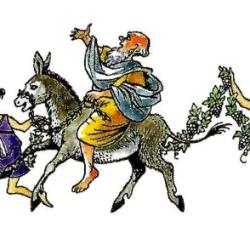Biology professor and long-time blogger Joel Duff looks at the latest attempt by “scientific creationists” to deal with Australia: “Divine Action: A New Solution to the Marsupial Migration Problem?”
As we’ve often mentioned here, Australia just refuses to comply with young-earth creationists’ magic-bullet theory that somehow Noah’s flood can explain away all of the evidence that life on this planet began millions of years ago, and not just 7,000 years ago. I’ve referred to this Australia problem as “The Long March of the Koalas” because, well, these folks claim that every living thing on Australia walked there from Mt. Ararat in Turkey some 4,200 years ago — every koala,* kangaroo, wallaby, wombat, Tasmanian devil, quoll, bandicoot, and platypus.
This is an amazing claim. An impossibility. As Duff puts it:
The question of how marsupials traveled from the Ark, located in the Middle East, to Australia without leaving populations along the way puzzles many. Why are there no native kangaroos in Asia or the Middle East if they traveled from the Ark to Australia? And maybe even more curious: if so many marsupial species could get from the Middle East to Australia why did NO placental mammals make the trip?
The young-earth creationist group Answers in Genesis has always been especially conscious of this impossible problem because its founder-president, Ken Ham, is from Australia. So for decades, AiG has addressed this question by noting that the literal Noah’s Ark settled on Mt. Ararat and then … hey, look over there!

Duff’s latest post (and YouTube video) looks at the latest scientific creationist approach to this problem, which involves abandoning the “scientific” part of that and just calling Australia’s marsupials the product of direct, miraculous divine intervention. How did the koalas get from Ararat to Oz? God picked ’em up and put them there. Literally.
Here Dr. Duff does his usual great job outlining both the scientific and theological problems this magic-wand solution creates. Here, as ever, young-earth creationism is both Bad Science and Bad Theology. The universe does not and cannot work this way. God does not and cannot work this way. The Bible does not and cannot work this way.
Duff’s video, like his blog, isn’t about dunking on creationists, but about understanding them. Part of why he’s good at this — why he’s able to patiently wade through apparent nonsense to make sense of it with clarity and charity — is because Duff seems to enjoy the fun part of creationism, which is the fun part of any bonkers conspiracy theory. It’s the fun of world-building and puzzle-solving, of letting your imagination run wild to try to make some dubious construct seem plausibly realistic. One gets the sense reading him that if he were a young-earth “scientific creationist,” he’d be a lot better at it than they are.
I think Duff appreciates that the realm of young-earth creationism is rife with cynical, bad-faith grifters as well as true believers, but he tends to focus on the work of the true believers. This is partly because it allows him to engage the strongest forms of their arguments and partly because he seems to genuinely respect and admire their conviction. He is, himself, a lifelong conservative Reformed Christian — an Orthodox Presbyterian pastor’s kid who attends a PCA church every week. The PCA both does and doesn’t fit in with white evangelicalism, but if Tim Keller was an “evangelical” then so is Joel Duff.
And that’s another really interesting aspect of the enormous contribution Duff has made with his years of patient, insightful, writing about “the intersection of science and faith.” He teaches at the University of Akron, and that secular public research institution has never disciplined him for his many, many posts about faith and theology. But if he taught at an evangelical college, like Wheaton, or at a PCA college, like Grove City, then he would never have been allowed to write a blog like this.
Ken Ham would get on the phone to one of that school’s big-money right-wing fundie donors and that donor would call the school and Philip Ryken** would have Duff summoned to the provost’s office where he’d be told to never mention marsupials again if he wants to keep his job and his house and his health insurance.
There are plenty of “Christian colleges” [white evangelical colleges] that would have no problem allowing a biology professor to teach students the things that Duff helps his readers and viewers learn online. But even at most of those schools he wouldn’t be allowed to blog about such things out in public, where just anybody could see it, including parents, donors, trustees (i.e., repeat donors), the white evangelical IndigNation, and all of the professional hatchet-men of the white evangelical Direct Mail Industry.
You can teach at a big secular research university and regularly post about God and the Bible without worrying that you’ll lose your job. But if you teach at some Christian colleges and you post the word “Sterkfontein” even just once, then not even tenure can save you.
* It would be impossible for two koalas or for seven koalas or for 14 koalas to walk thousands of miles, and then to swim or raft thousands more, to reach Australia, but the two or seven or 14 question still distracts me here.
In one of the (poorly merged) Noah stories in Genesis, we are told that Noah’s Ark was a refuge to “seven” or perhaps to “seven pairs” of “every clean animal” and “and one pair of every kind of unclean animal, a male and its mate.” So were koalas included among the clean or the unclean?
To answer that question, you might be tempted to turn to a passage like Deuteronomy 14 and to ponder its distinctions regarding cloven hooves and cud chewing, but those are the laws of Moses and Noah’s story is in the prehistory of Genesis, a book that includes a story about God and Abraham enjoying a meal of meat and dairy. So if you want to argue that “clean and unclean” means the same thing in this story as it does in Deuteronomy, then you’ve got a screaming anachronism on your hands. (Even more so than the anachronism of those camels in Deuteronomy 14.)
Under the anachronistic laws of Deuteronomy 14, I suppose koalas are unclean. That sounds judgmental, like we’re condemning them as immoral because, after all, good animals don’t get the Clam. But mainly the category of “unclean” just means “animals you shouldn’t eat,” and I don’t think anybody should be eating koalas.
So, OK then, if koalas are “unclean,” and Noah’s Ark included “one pair of every kind of unclean animal, a male and its mate,” then the answer to “How Many Koalas Were on Noah’s Ark?” should be “Two,” right?
Wrong. Because, again, screaming anachronisms are a Bad Thing that we would like to avoid. The story(-ies) of Noah’s Ark was written by people who did not know or need to know or imagine that a continent of marsupials existed thousands of miles away. And it was written for people who did not know or need to know or imagine that a continent of marsupials existed thousands of miles away. For the writers and intended readers of this story, “every kind of unclean animal” did not include marsupials or need to include them. If you’re reading them back into a story that never included them, that’s more of a You problem.
** I am depicting Wheaton College president Philip Ryken as a craven buffoon who routinely fires respected and beloved professors because he’s the bought-and-paid-for puppet of right-wing millionaire idiots because, you see, Ryken has done exactly this for exactly this reason.
Twice.

















